Folkestone in Kent has long played second fiddle to its busier neighbour Dover. As is the case with so many other famous seaside resorts across the UK, before Brits flew abroad for getaways, the area flourished from the Edwardian period all the way up to the 1950s and early 60s. But, in more recent times, the town has seen a decline, as its ferry port closed in the early 2000s, and the Channel Tunnel took control of travel back and forth between the UK and France.
Businessman Sir Roger De Haan, 75, grew up in Folkestone and stayed in the area until he was a teenager. Later, he sold his parents' holiday business, Saga, and started to invest £100million into regenerating his home town. "When I grew up in Folkestone as a teenager, there was nothing to do." Sir Roger tells the Express. "It was incredibly grim. Now, there's an awful lot for kids to do, for families to do." He adds: "Like many seaside towns in Britain, Folkestone went into decline, and I watched that happen. There used to be hundreds of hotels, and now there are a tiny number."
"I love the place, he adds. "I grew up here. I worked in Folkestone. Saga's headquarters were always in Folkestone. I had my kids in Folkestone. I've always lived in Folkestone, or the surrounding area. I do have an emotional attachment to it." The philanthropist describes how, when he started pumping cash into the area, much of it had become a neglected "slum", as a new town centre had marginalised the old parts, which "declined more rapidly than everywhere else".
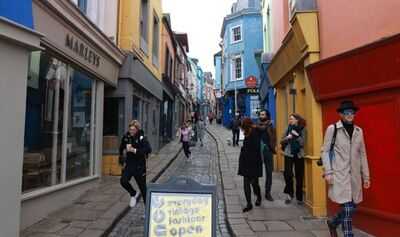
Sir Roger's father Sidney "predicted that tourists, when they discovered overseas holidays, would turn their back on Folkestone," the businessman says. "I think he would be really happy that, Folkestone, in a way, has been reinvented, and people have discovered it again, and are coming back in large numbers."
Today, the resort's Creative Quarter is a sign of its transformation into a trendy tourist hub filled with 80 independent traders, which has attracted visitors from as far away as east Asia, as well as plenty of Londoners, who have moved permanently to the coast to enjoy a slower and more peaceful existence.
Sir Roger says: "When I started this project, almost all of them [the shops] were empty.
"Some were boarded up, and most of them they didn't even bother to board up."
He bought up around 90 "slum buildings", and gave a 125-year lease for the properties to his arts charity for "a peppercorn rent".
"Because of this formula," he says, "it should still be successful in 100 years' time, because it hasn't got a commercial landlord.
"It's got a charity landlord who doesn't have to pay anything for the rent."
In addition, Folkestone has seen substantial investment in its education system and sports facilities.
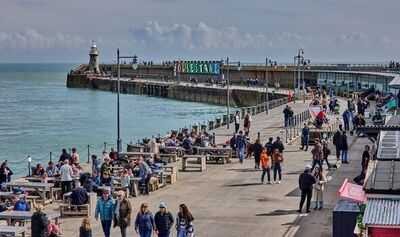
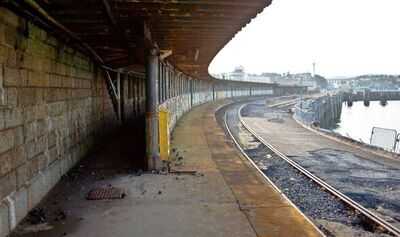
This is by no means the end of changes locally, as the next controversial phase to develop the harbour, which includes tower blocks of 1,000 homes and 10,000 square metres of commercial space, was given the green light in June.
When asked if he risks building something locals do not want, Sir Roger says: "I've built a lot of buildings in Folkestone and I used Norman Foster, one of the world's great architects, to design the Folkestone Academy [secondary school].
"I used [fellow renowned architect] Sir Michael Hopkins to design Saga's corporate headquarters."
He also points out that the F51 Sports Centre has been highly commended.
"And I'm using really fine architects on the seafront," the businessman adds. "The first building we've put up has won all sorts of awards.
"And people like it. I'm spending a vast amount of time and effort to get this right. And I think it'll be lovely."
Artist's impressions of the futuristic apartments that will be built around the harbour look like something you'd be more likely to find in Dubai, Monte Carlo or perhaps at the very least fashionable Brighton, further along the south coast.
And this leaves some feeling uneasy.
When Mike O'Donoughue, 67, the owner of Plectrums and Paints in the Creative Quarter, arrived in Folkestone 20 years ago, the area was "derelict", but he fears potential downsides to the improvements.
"Brighton is scary, and I don't think we really want to be heading that way here," he says.
"I think they could be a bit more lenient on the parking [in Folkestone] especially at weekends."
Sir Roger assures his critics he does not want to turn Folkestone into Brighton.
He adds: "Folkestone has its own personality that's unique. We've got the white cliffs. You can see France, you can see France quite often.
"It's surrounded with lovely countryside. It's a great place to live. It's a great place to work. And, no, we're not trying to turn it into some other place."
Revised harbour upgrade plans include 323 spaces for cars, but this is reportedly still about half of the current total of 615.
Mr O'Donoughue also mentions that some local people "feel like they're being ousted, slightly", and describes how 15 years ago, houses and flats could be come by "quite cheaply".
"And now," he adds, "it seems they're in line with most other places along the coast."
According to Rightmove, house prices in Folkestone had an overall average of £320,757 over the last year, far higher than the average UK property pricereported in June of £265,000.
"One of the challenges with regeneration is that rents go up and house prices go up," Sir Roger says.
"But they needed to go up a bit because the housing stock in Folkestone was getting very, very rundown.
"And one of the reasons people weren't investing in their rundown house... is when you've done up your house, you need to know it's worth what you paid for it and how much you spent in doing it up."
He adds: "Some people say the houses we're building on the seafront aren't for them. But why should they be?
"You can't build houses for everyone. It's not as if we've knocked down any. We didn't knock any houses down to build these houses. It was a brownfield site.
"But the jobs that will be created will, again, be good for the local economy."
Ben, who does not wish to provide his name nor age, a staff member at the Bounce Vintage clothes shop, says: "I'm a little bit conflicted about the whole thing.
"Roger de Haan has regenerated, but on the other hand he does feel like a bit of a feudal baron.

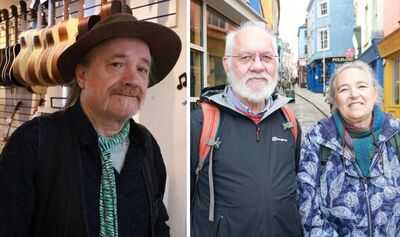
"He owns the harbour, and stall-holders [there] don't know where they stand.
"They don't know if they're going to be kicked out eventually, like in the east end of London."
Sir Roger says there is a plan in place to move stall-holders to a temporary site.
He details that building work is currently taking place westwards, and this will stop when it reaches a certain point so that businesses impacted can be moved above the beach, where the town's funfair used to be, while buildings go up.
When they return, some will be operating again from stalls, while others will be moved into "permanent" commercial units, such as pubs and bars.
"We very much want to protect them and protect their businesses," the entrepreneur says.
On the feudal comment, Sir Roger retorts: "If that means old fashioned, well, I don't think what we're doing is old fashioned.
"If it means they're all vassals and that I'm their lord, that's just silly.
"You know, I needn't have done it. I'm very pleased I did it, because I think it's been successful.
"I think the town is in a really good place."
Mr O'Donoughue suggests that some are concerned that the newest development could be an "eyesore".
Sir Roger responds: "It took me almost 10 years to get planning consent.
"But then it's taken me another 10 years to complete the planning, to get what they call reserve matters.
"And not everybody agrees with it, but you never get everybody agreeing with it."
There has been "a massive amount of public consultation", he emphasises, adding: "It's been incredibly exhausting and time consuming, and we've got there. Some of the people don't like the artists [as the town is full of street art and art galleries], don't like what's happening.
"But they've often got very short memories."
Young people used to leave Folkestone to get work elsewhere, including in the UK's capital, the entrepreneur adds, and people's kids and grandkids couldn't find work.
"That is quickly forgotten," Sir Roger says.
"Now we've probably got the most successful high street in the land, and the local economy is doing better and better."
Some locals argue that, despite the improvements, the area is "schizophrenic" in that some areas still feel left behind.
Steve Smith, 69, a church organist who lives in the little village of Smeeth just outside the town, says of Folkestone: "There's money, and there's the millionaire's flats along the front.
"But then you can see just looking around the place that there's still huge poverty as well."
His wife, Gianna Marchesi, 69, a school caretaker, rues the loss of the resort's classic amusements.
"It was actually quite fun, occasionally, to come down and enjoy it with the children, or without the children," she says.
"And the market on a Sunday was quite fun."
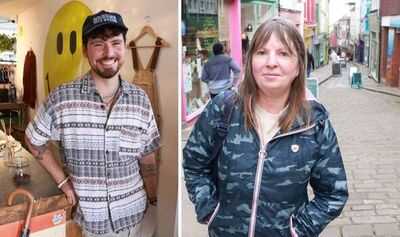
Brian Frost, 64, was born in Folkestone.
"It's not what it was like when I was a kid," he tells the Express next to his pride and joy, a red 1990s Peugeot.
He adds that it's full of cafés, nail bars, hairdressers and betting shops.
But he adds: "It hasn't impacted me personally, but that Mr De Haan, he's doing loads of stuff.
"Good for him."
He needs to sort out the potholes on the town's "terrible" roads, though, the former London tipper lorry driver adds.
Jane Gowan, 61, a stall-holder at the town's indoor market who specialises in photography, says that development is all well and good, but adds: "There are a lot of works going on, and they're all at once.
"It's a bit of a mess, really.
"Espically with the traffic and everything, roadworks and stuff.
"The high street was really rundown [but] I think they're trying to do too much all at once now."
A spokesperson for Folkestone and Hythe District Council tells the Express that a £22million government funded scheme includes "significant improvements" to the area around the railway station, as well as upgrades to Folkestone's road network "to address the legacy from when the roads served Folkestone well when it was a port town which are no longer appropriate".
When asked if he is planning any more schemes to enhance Folkestone, Sir Roger says that he is "knackered", but feels that he has left the town in a good place.
"I think more people will move down from London, because the people bidding for the new franchise on the high speed train [line] are talking about increasing the frequency of trains from Folkestone," he says.
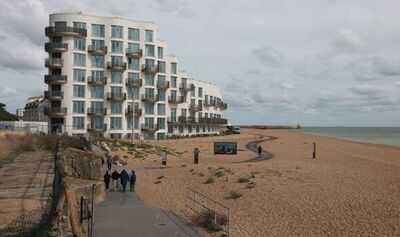
"So I think Folkestone will become more and more attractive for people living in the town and visitors.
"Over the next 10 years there will be quite a lot of investment in hotels in the town.
"COVID saw the British rediscover taking a holiday in Britain, and so I think we'll see a reinvigoration of the hotel trade in the town, and we're seeing people beginning to invest in hotels now."
The businessman believes that other British seaside towns do not need someone like him in order to see better days, as he urges the Heritage Lottery Fund, the Arts Council and Sport England to work collaboratively and target small sums of money over a 10- or 15-year period to fund schemes in places like Weston-super-Mare, Blackpool, Great Yarmouth and Skegness.
"Everybody thinks about just a five-year plan," he says.
"But regeneration takes longer than that, so you've got to have a longer plan.
"But it doesn't need a philanthropist to do it.
"It can be done with the agencies we have in the country now."
You may also like

The new £12.6bn Suez Canal rival that will create incredible Europe Asia short cut

Women's World Cup 2025: India Women vs Pakistan Women Highlights & Result – Match 6

Chandrababu Naidu turning Andhra into "number one state" in spurious liquor trade: YSRCP chief Jagan Reddy

Ministry of Panchayati Raj launches People's Plan Campaign (PPC) 2025-26

Women's World Cup: 'I'm Sure Everyone Back Home Is Happy As Well', Says Harmanpreet After Big Win Over Pakistan







